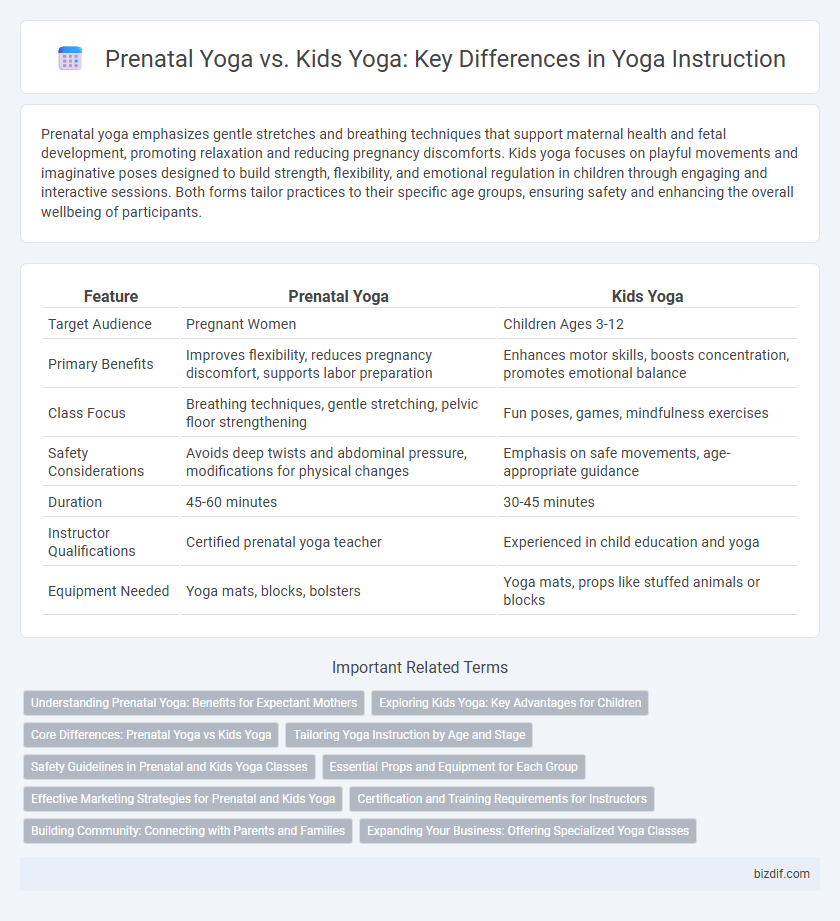Prenatal yoga emphasizes gentle stretches and breathing techniques that support maternal health and fetal development, promoting relaxation and reducing pregnancy discomforts. Kids yoga focuses on playful movements and imaginative poses designed to build strength, flexibility, and emotional regulation in children through engaging and interactive sessions. Both forms tailor practices to their specific age groups, ensuring safety and enhancing the overall wellbeing of participants.
Table of Comparison
| Feature | Prenatal Yoga | Kids Yoga |
|---|---|---|
| Target Audience | Pregnant Women | Children Ages 3-12 |
| Primary Benefits | Improves flexibility, reduces pregnancy discomfort, supports labor preparation | Enhances motor skills, boosts concentration, promotes emotional balance |
| Class Focus | Breathing techniques, gentle stretching, pelvic floor strengthening | Fun poses, games, mindfulness exercises |
| Safety Considerations | Avoids deep twists and abdominal pressure, modifications for physical changes | Emphasis on safe movements, age-appropriate guidance |
| Duration | 45-60 minutes | 30-45 minutes |
| Instructor Qualifications | Certified prenatal yoga teacher | Experienced in child education and yoga |
| Equipment Needed | Yoga mats, blocks, bolsters | Yoga mats, props like stuffed animals or blocks |
Understanding Prenatal Yoga: Benefits for Expectant Mothers
Prenatal yoga offers expectant mothers improved flexibility, reduced pregnancy-related discomfort, and enhanced mental relaxation, contributing to a healthier pregnancy. This practice emphasizes gentle stretching, breathing techniques, and posture alignment tailored to the changing body during pregnancy. Unlike kids yoga, prenatal classes focus on supporting maternal wellness and preparing for childbirth through safe, pregnancy-specific exercises.
Exploring Kids Yoga: Key Advantages for Children
Kids Yoga enhances physical flexibility, balance, and coordination while promoting emotional resilience and concentration. It supports cognitive development through playful poses and mindfulness exercises tailored to children's needs. Engaging in kids yoga fosters social skills and reduces anxiety, making it a valuable practice for holistic childhood growth.
Core Differences: Prenatal Yoga vs Kids Yoga
Prenatal yoga emphasizes gentle stretches, breathing techniques, and relaxation to support pregnancy health, focusing on pelvic floor strength and reducing prenatal discomfort. Kids yoga incorporates playful poses, imaginative storytelling, and balance exercises designed to enhance motor skills, concentration, and emotional regulation in children. The core difference lies in the tailored approach where prenatal yoga aims to accommodate bodily changes and maternal well-being, while kids yoga fosters development through fun and interactive movement.
Tailoring Yoga Instruction by Age and Stage
Prenatal yoga emphasizes gentle stretching, breath control, and relaxation techniques tailored to support pregnancy-related physical changes and mental well-being, while kids yoga incorporates playful poses, storytelling, and interactive games to engage young minds and develop motor skills. Instructors adjust sequences based on age-specific needs, focusing on safety, balance, and developmental milestones to maximize benefits. Customizing yoga practice by age and stage ensures appropriate intensity, promotes physical health, and fosters emotional growth for both expecting mothers and children.
Safety Guidelines in Prenatal and Kids Yoga Classes
Prenatal yoga classes prioritize gentle, controlled movements and avoid poses that compress the abdomen or involve deep twists to ensure the safety of both mother and baby. Kids yoga emphasizes age-appropriate poses with close supervision, avoiding complex or strenuous positions to prevent injury and maintain engagement. Both disciplines require certified instructors who understand specific developmental and physiological needs to create a secure and supportive environment.
Essential Props and Equipment for Each Group
Prenatal yoga requires supportive props such as bolsters, blocks, and straps to enhance comfort and stability during gentle stretching and breathing exercises essential for pregnancy. Kids yoga benefits from colorful mats, playful props like stuffed animals, and interactive tools to engage young learners and promote balance and coordination. Tailoring equipment to each group's physical and developmental needs ensures safety and maximizes the effectiveness of the yoga practice.
Effective Marketing Strategies for Prenatal and Kids Yoga
Targeted advertising on social media platforms like Instagram and Facebook enhances visibility for prenatal and kids yoga classes by reaching specific demographics such as expectant mothers and parents. Collaborations with healthcare providers and schools build trust and provide direct access to potential clients, while offering free trial sessions encourages engagement and commitment. Utilizing testimonials and showcasing safety and developmental benefits in marketing materials increases appeal and drives enrollment.
Certification and Training Requirements for Instructors
Prenatal yoga instructors must complete specialized certification programs that emphasize anatomy, safety protocols, and prenatal health considerations to support expectant mothers effectively. Kids yoga instructors require training focused on child development, playful teaching methods, and creating engaging, age-appropriate sequences for young learners. Both certifications often involve continuing education to stay updated with evolving best practices and safety standards in their respective fields.
Building Community: Connecting with Parents and Families
Prenatal Yoga classes foster a supportive environment where expectant mothers connect and share experiences, creating a strong sense of community among parents-to-be. Kids Yoga sessions engage not only children but also their parents and families, promoting family bonding through interactive poses and mindfulness activities. Both yoga types emphasize building meaningful relationships, enhancing social support networks essential for family well-being.
Expanding Your Business: Offering Specialized Yoga Classes
Offering specialized yoga classes such as Prenatal Yoga and Kids Yoga allows instructors to target distinct client demographics, increasing market reach and revenue potential. Prenatal Yoga focuses on gentle, safe postures and breathing techniques tailored for expectant mothers, while Kids Yoga emphasizes playful movement and mindfulness to support child development. Expanding your business with these niche offerings enhances your brand's versatility and attracts a broader range of students seeking age and condition-specific wellness practices.
Prenatal Yoga vs Kids Yoga Infographic

 bizdif.com
bizdif.com